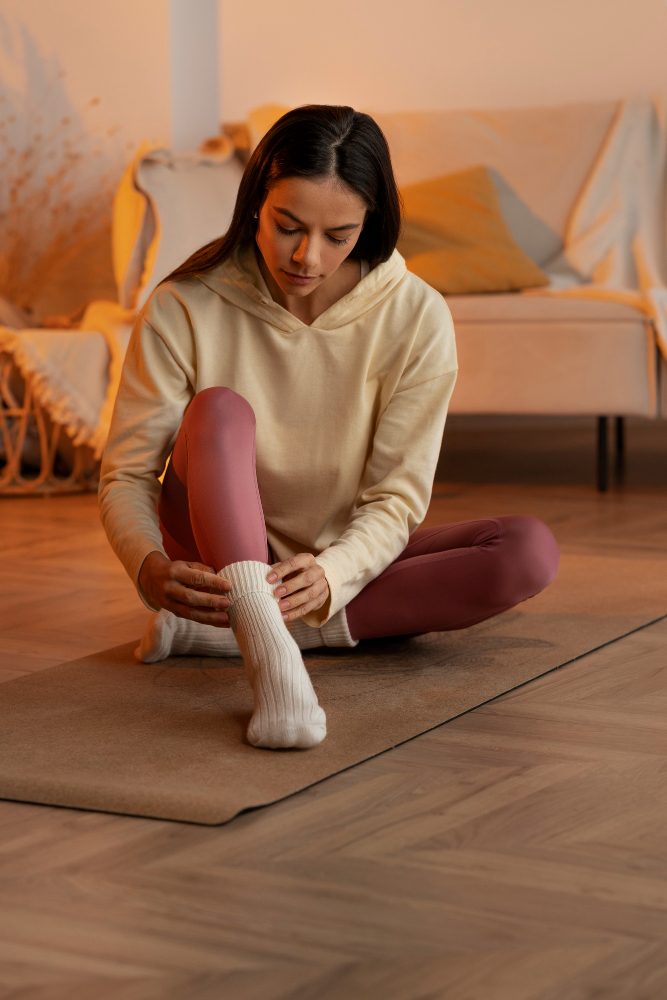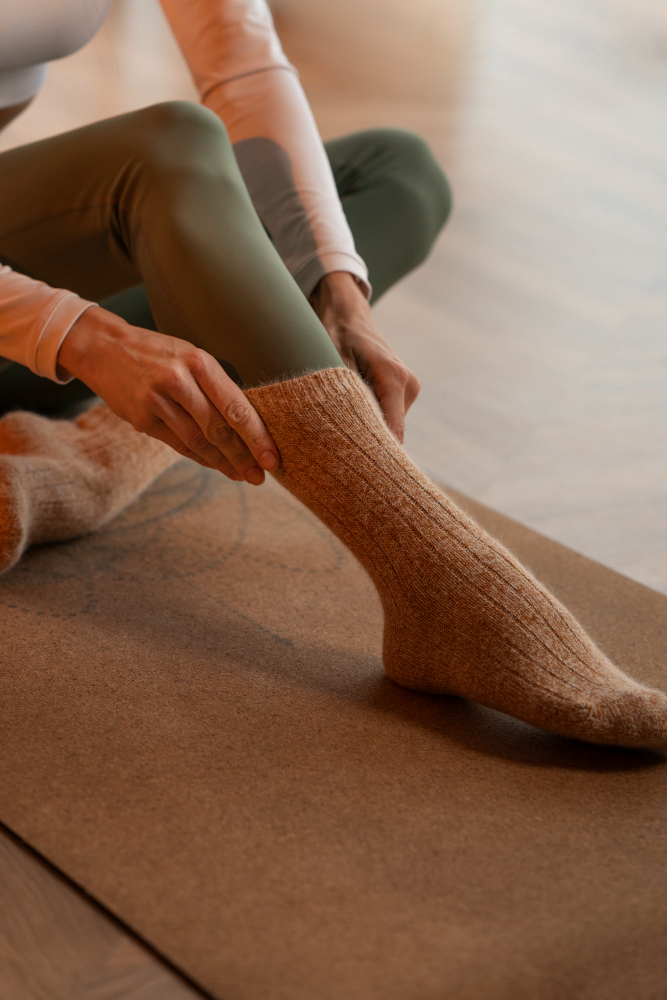Table of Contents
Introduction
Yoga socks might seem like a minor accessory in the grand scheme of your yoga practice, but these little wonders can make a significant difference. Whether you’re practicing on a slippery surface or simply want extra comfort, yoga socks can be a game-changer. So, what exactly are yoga socks, and why should you consider adding them to your yoga gear? Let’s dive in and find out.
What Are Yoga Socks?
Yoga socks are specially designed socks that provide better grip, support, and hygiene during your yoga practice. They come in various styles and materials to suit different needs and preferences.
Why Yoga Socks Are Essential
You might be wondering, “Do I really need yoga socks?” The answer is a resounding yes! Yoga socks offer numerous benefits that can enhance your overall experience on the mat. From preventing slips to keeping your feet warm, these socks are more than just a fashion statement.
Benefits of Yoga Socks
Yoga socks offer several advantages that can improve your practice and overall experience. Here are some key benefits:
- Better Grip: Yoga socks provide enhanced traction on your mat, helping prevent slips and falls. This is especially useful for poses that require stability and balance.
- Hygiene: Using yoga socks creates a barrier between your feet and the mat, reducing the risk of fungal infections and other foot-related issues. This is particularly important if you practice in a shared studio space.
- Warmth: Yoga socks keep your feet warm, which can be especially beneficial during the cooler months or in air-conditioned studios. Warm muscles are more flexible and less prone to injury.
- Support: Many yoga socks come with additional support features, such as arch compression, which can provide extra comfort during your practice.
- Versatility: These socks are suitable for various types of flooring, whether you’re practicing on a yoga mat, hardwood floor, or carpet. They adapt well to different surfaces, making them a versatile accessory for your routine.
- Protection: Yoga socks can protect your feet from minor injuries, such as cuts or scrapes, especially if you practice outdoors or in an unfamiliar environment.
- Style: Available in a variety of colors and designs, yoga socks allow you to express your personal style while practicing. They can be a fun and fashionable addition to your yoga wardrobe.
Types of Yoga Socks
Yoga socks come in various styles, each designed to cater to different preferences and needs. Here are some common types:
- Toe Socks: These socks have individual compartments for each toe, similar to gloves for your feet. They offer maximum toe mobility and help improve balance and alignment during your practice.
- Half-Toe Socks: These are like toe socks but with open toes. They provide a barefoot feeling while still offering grip and protection. The open-toe design allows for better airflow and a more natural feel.
- Full-Toe Socks: These socks cover the entire foot, providing full protection and warmth. They are ideal for those who prefer a traditional sock feel but still want the added grip for yoga practice.
- Grip Socks: Grip socks feature non-slip patterns on the soles, usually made of silicone or rubber. These patterns provide excellent traction, making them ideal for maintaining stability on various surfaces.
- Ballet-Style Socks: Inspired by ballet slippers, these socks often have straps across the top of the foot for added style and security. They combine the elegance of ballet with the functionality of yoga socks.
- Compression Socks: These socks offer gentle compression to improve blood circulation and provide additional support. They are beneficial for those who experience swelling or fatigue in their feet during or after yoga sessions.
- Ankle Socks: These socks reach just above the ankle, offering a minimalistic design that is lightweight and easy to wear. They are great for those who prefer less coverage while still benefiting from the grip.
- Knee-High Socks: These extend up to the knee, providing extra warmth and support. They are suitable for colder environments or for those who want additional leg coverage during their practice.
Choosing the right type of yoga sock depends on your personal preferences and the specific requirements of your yoga practice. Each style offers unique benefits to help you achieve a comfortable and stable yoga experience.

Materials Used in Yoga Socks
Yoga socks are crafted from a variety of materials, each chosen for its specific properties to enhance comfort and performance. Here are some common materials used:
- Cotton: Cotton is a popular choice for yoga socks due to its softness and breathability. It helps keep feet cool and comfortable by allowing air circulation and absorbing moisture.
- Polyester: Polyester is a durable and quick-drying material. It is often blended with other fibers to add strength and help wick away sweat, keeping your feet dry during intense sessions.
- Spandex: Spandex provides elasticity, allowing the socks to stretch and fit snugly on your feet. This material helps maintain the shape of the socks and provides a secure fit during movement.
- Nylon: Nylon is known for its strength and resistance to wear and tear. It is often used in yoga socks to add durability and enhance their longevity, even with frequent use.
- Bamboo: Bamboo fibers are naturally soft, breathable, and antibacterial. Socks made from bamboo are gentle on the skin and help prevent odors, making them an excellent choice for yoga practice.
- Wool: Wool is a natural insulator, keeping your feet warm in cooler conditions. It also has moisture-wicking properties and is resistant to odors, making it suitable for yoga socks used in different environments.
- Silicone/Rubber: These materials are used for the non-slip patterns on the soles of yoga socks. They provide grip and traction, helping prevent slips and ensuring stability during practice.
- Acrylic: Acrylic fibers are lightweight and provide warmth without being bulky. They are often blended with other materials to add softness and comfort to yoga socks.
Related Article: Link to the article on Creating a Yoga Practice: A Comprehensive Guide to provide additional context on starting a yoga practice.
How to Choose the Right Yoga Socks
Selecting the right yoga socks can make a significant difference in your practice. Here are some key factors to consider:
- Fit: Choose socks that fit snugly without being too tight. A good fit prevents slipping and bunching, providing stability and comfort during your sessions.
- Grip: Look for socks with non-slip patterns on the soles. These patterns, usually made of silicone or rubber, provide traction and help maintain balance on different surfaces.
- Material: Consider the material of the socks. Cotton is breathable and comfortable, while polyester and nylon offer durability and moisture-wicking properties. Bamboo and wool are good for natural odor resistance and warmth.
- Toe Design: Decide between full-toe and half-toe designs. Full-toe socks cover the entire foot, offering more protection, while half-toe socks allow for more natural toe movement and breathability.
- Compression: Some yoga socks come with compression features that provide additional support and improve blood circulation. These are beneficial if you experience swelling or fatigue in your feet.
- Length: Yoga socks come in various lengths, from ankle to knee-high. Choose the length based on your comfort and the type of coverage you prefer. Ankle socks are minimalistic, while knee-high socks offer extra warmth and support.
- Style: Yoga socks come in a variety of colors and patterns. While style may not affect performance, choosing a design you like can make your practice more enjoyable.
- Purpose: Consider where and how you practice yoga. If you practice on different surfaces, grip socks are essential. For outdoor practice, socks with thicker material might be more suitable.
Related Article: Mention the benefits of yoga socks in the context of Chair Yoga for Seniors: A Free Guide to Enhanced Wellbeing, emphasizing hygiene and comfort.
Top Yoga Sock Brands
When it comes to yoga socks, several brands are well-known for their quality, comfort, and performance. Here are some top brands to consider:
- ToeSox: ToeSox is famous for its toe-separated design, which offers great grip and natural toe movement. Their socks come in various styles, including full-toe, half-toe, and ankle-length options.
- Gaiam: Gaiam provides a range of yoga products, including grip socks that are designed for stability and comfort. Their socks often feature anti-slip patterns and are available in multiple designs and colors.
- Tavi Noir: Tavi Noir offers stylish and functional yoga socks with non-slip grips. They focus on combining fashion with performance, providing a variety of patterns and styles to suit different preferences.
- Bombas: Known for their comfortable and durable socks, Bombas also has a line of yoga socks. They focus on high-quality materials and construction, offering excellent grip and support.
- Grip & Grit: This brand specializes in grip socks that provide excellent traction and comfort. They offer a range of styles, from ankle to knee-high, catering to different needs and preferences.
- Shashi: Shashi socks are known for their elegant design and functional performance. They feature mesh tops for breathability and non-slip soles for stability, making them a popular choice among yoga enthusiasts.
- LA Active: LA Active produces affordable and high-quality grip socks suitable for yoga and other activities. Their socks are known for their durability and strong grip, making them a reliable choice for regular practice.
- Bombshell: This brand offers unique and colorful designs, ensuring you can find socks that match your style while providing the necessary grip and comfort for your practice.
Related Article: Highlight the importance of proper yoga attire in The Ultimate Guide to Choosing Your Yoga Mat to draw a connection between choosing the right mat and the right socks.
DIY Yoga Socks: Make Your Own
Materials Needed
- A pair of regular socks
- Fabric glue or needle and thread
- Rubberized fabric paint
Step-by-Step Instructions
- Start with a pair of clean, regular socks.
- Cut out small shapes from rubberized fabric paint and glue them to the bottom of the socks.
- Let the glue dry completely before using the socks.
Common Mistakes When Using Yoga Socks
Choosing the Wrong Size
Wearing socks that are too big or too small can cause discomfort and reduce their effectiveness.
Ignoring the Material
Not considering the material can lead to discomfort, especially if you have sensitive skin or specific needs.
Not Washing Regularly
Regular washing is essential to maintain hygiene and extend the lifespan of your yoga socks.
FAQs About Yoga Socks
Do I need to wear yoga socks?
While not mandatory, yoga socks offer benefits like improved grip, hygiene, and comfort.
Can I use regular socks for yoga?
Regular socks might not provide the necessary grip and support, making yoga socks a better option.
How do I wash my yoga socks?
Follow the care instructions on the label. Generally, a gentle machine wash and air drying are recommended.
Are there eco-friendly yoga socks?
Yes, socks made from materials like bamboo and organic cotton are eco-friendly options.
Can yoga socks help with foot pain?
Some yoga socks with extra arch support can help alleviate foot pain by providing better alignment and support.







